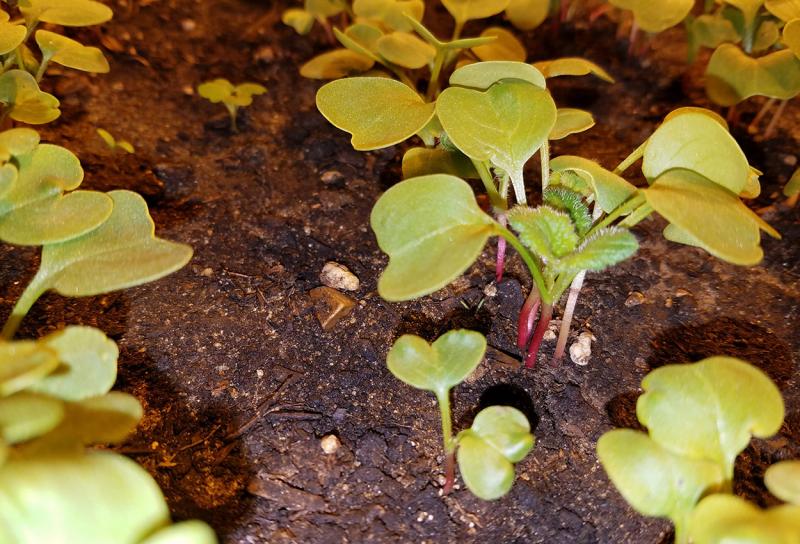Written by Cindy Schnabel, SDSU Extension Horticulture Assistant and Master Gardener, under the direction and review of Kristine Lang and Rhoda Burrows, former Professor & SDSU Extension Horticulture.
About Radishes
The radish (Raphanus sp.) is a cool-weather vegetable with a long history. It is believed that radishes were cultivated in Egypt as early as 2700 B.C., with domestication of radish occurring in China as early as 500 B.C. In ancient Egypt radish seeds were pressed for oil. The people who built the pyramids were said to have been paid in onions, garlic and radishes. Greek history texts note that the radish was replicated in gold and offered to the god Apollo. Radishes were used as a medicine in early Rome. Thought to have antibacterial properties, radishes were used to alleviate stomach and intestinal problems.
Planting and Care

Radishes can be planted early in the growing season, as they germinate in soils temperatures as low as 40 degrees Fahrenheit. The seeds sprout in less than a week, and many varieties only take 30 days to mature. This nearly immediate gratification makes them a good option for children’s gardens. In order to grow radishes, plant the seeds between a quarter-inch and a half-inch deep and three-quarters of an inch apart, preferably in loose, well-amended soil. Water them daily until you see the leaves above ground, which should happen in three to six days. Keep the bed moist until the roots start to form. Radish leaves block out the sunlight, so weeds will not grow underneath them. To keep producing fresh radishes throughout the cool, spring growing season, plant more seeds every two weeks.
Varieties
There are two classifications of radishes, spring and winter varieties.
Spring: Spring radishes, which love cool temperatures, are the most common. Spring radish varieties include Cherry Belle (red), Helios (golden), Pink Beauty, Purple Plum and White Hailstone (completely white inside and out). A newer variety to try is called Mardi Gras. The seed packets contain radishes in a variety of spice levels and colors, including mild-flavored white and yellow, spicy purples and earth-tasty black ones. Spring radishes are best when they are smaller than one inch in diameter, because they become fibrous if larger, ruining the taste and making them difficult to bite. Later, in cool, fall temperatures, you can replant spring radish varieties and again enjoy fresh radishes.
Winter: Winter radishes are grown in late summer or fall and can be eaten when picked or stored over winter. Asian radish varieties fall under this category. The more-common varieties are China Rose (long, deep red), Chinese Red Meat (also called Watermelon radish), Japanese Minowase Daikon (carrot shaped, white skin), Long Black Spanish (tapered, black skin) and Round Black Spanish (large, black skin). Winter radishes are usually larger than spring radishes when they are mature, and also take longer to grow. The Daikon’s shoulders will stand up out of the soil, giving you an idea of the width of the edible root. You can harvest them when the root is eight inches long and keep harvesting them until a killing frost. Use a spade or fork to dig them up. These radishes will stay crisp through storage. Their taste is stronger than a spring radish. Daikon varieties of winter radishes can grow up to 24 inches long and three inches in diameter. The ‘Red Meat’ and ‘Black Spanish’ varieties taste better when they are about four inches in diameter. Daikon radishes are sometimes referred to as “tillage radishes,” because farmers and gardeners use them as a cover crop. Their long taproot creates air pockets, reducing compaction, and replenish nutrients in the soil when the radishes decay after a hard freeze kills the plant.
All-Season: Varieties, like the heirloom variety ‘French Breakfast’ (thin, red with white tips), ‘Icicle’ (slim, tapered, white) and ‘Rat’s Tail’ (usually grown for the seed pods) are considered all-season, or specialty varieties.
Pest Management
Radishes do attract some pests, such as flea beetles, slugs, aphids and cabbage loopers. Flea beetles, which are small and have shiny coats and large rear legs, can be a problem. They feed on the leaves and stems of the radish. Leaves will show shallow pits and round, irregular holes (like shot holes). Dusting with insecticide powder or using sticky traps help to get rid of flea beetles. Slugs can be killed by drowning traps, diatomaceous earth or granular slug baits. Aphids can be treated by spraying plants with diluted neem products, or even with diluted dish soap. Cabbage looper damage can be reduced with biological controls ,such as predatory insects or by removing the caterpillars manually. Avoid broad-spectrum insecticides to minimize impact of control efforts on non-target insect species.
If allowed to flower, radishes will attract honeybees and beneficial insects to your garden. It is thought that radish plants repel cucumber beetles, squash borers and corn borers when allowed to flower. They might even draw leaf miners away from spinach and spider mites away from tomatoes.
Harvest and Preparation
Many people do not realize that radish greens are edible. Although they have a prickly underside, cooking makes them easier to eat. Be sure to wash the leaves well to remove any traces of garden soil. Some cooks sauté them in butter and stir them into rice, or use them in Indian dishes along with cumin, garlic and tomato and with Swiss chard and soy sauce and toasted sesame oil.
Special thanks to SDSU Extension Master Gardeners Tim Schreiner and Stacy Dreis for serving as volunteer copy-editors of this article.


